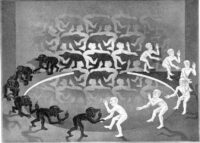Conventionally, time as we know it is a socially-constructed artifact of civilization. Subject to the application of widely differing schemes, intervals, periods, adjustments and methods of tracking, time has been variously rendered according to the seasons, phases of the moon, growth habits of trees, birth cycles of animals, planetary rotation, appearance of constellations in the night sky, mechanical devices, and the oscillation of atomic nuclei.
In my case, I mark time in prescription refills.
Moon-time had an awfully good run. A yearly 13-month calendar of 28 days each matched the moon’s cycle, and added up to a neat 364 days. The extra day was given a special designation, much as our periodic leap year adjustment. Notably, the 28-day moon cycle was synchronous with the female menstrual cycle; moon-based calendars went the way of moon-worshipping, goddess-based societies when male sun-worshipping, god-based cultures invaded and replaced them by force. We’ve had to deal with 12 confusing months of 28, 30, and 31 days ever since. Nice job, guys.
Marking time by the seasons worked pretty well for tens of thousands of years, except in Southern California where there is only one season, called Oscar. Seriously though folks, seasonal cycles were about food, and few things force us to mark time better than our stomachs. Winter’s end meant that hibernating animals would awaken, plants would sprout their tenderest shoots, snows would melt, springs would fill, fish gotta swim and birds gotta fly. And, oh yes, mass migrations would begin and everybody could eat well again for a while.
The heavenly constellations provide a nice time-piece. Since the earth tilts on its axis, one constellation after another rises and sets seasonally above night’s horizon. The appearance of Sirius (the Dog Star) in the constellation Canis Major marked the yearly beginning of the flooding of Nile (upon which the ancient Egyptians depended to irrigate the land), the coming of winter to the Polynesians and the blisteringly hot “Dog Days” of Greek summer. It helped that Sirius is the brightest star in the night sky; it’s actually a binary star system, a fact mysteriously known to the ancient Dogon people of Mali, Africa. They attribute their knowledge to amphibian extra-terrestrials who came to earth and told them all about it. Sounds better than an uncomfortable alien probe.
Mechanical clocks were a world-changing invention seemingly independent of the forces of nature; the pendulums, wound springs, tiny gears and precise movements gave rise to technological society obsessed with slices of time. Unfortunately mechanical devices are subject to subtle forces; heat, cold, movement, position and gravity all affect their accuracy. The search for absolute precision led to the atomic clock, in which atoms of cesium-133 and the microwaves emitted by their oscillations form the standard by which all other time pieces are measured. In this way the duration of one second has been firmly established. This is, incidentally, bad news for Dagwood Bumstead.
This brings me to my prescription refills. Now that I have retired from working for a living my sense of time has changed. Tuesday? Feels like Saturday to me. Three AM? Good time to write a column. One moment is indivisible from the last. I know a month has passed when my phone rings and an automated voice says my Lipitor is ready to pick up. Time? There ain’t no such thing.




